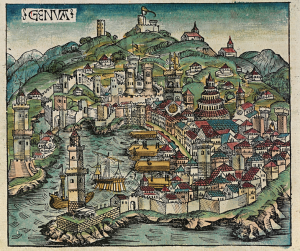I first visited Genoa, or Genova as the Italians call it, in 2005, while writing Siege. My first day there, my wife and I spent the afternoon wandering the medieval quarter, a network of quiet, shaded courtyards connected by narrow passages that cut between three- and four-story buildings. As dusk settled, we came upon a courtyard where a café had set up tables beneath an olive tree. The locals were out, drinking wine and feasting upon delicious-looking antipasti. We sat down, and before we had even ordered drinks, the waiter brought us a plate loaded with prosciutto, olives, cheese, marinated peppers, and nuts. “Quanto costa?†I asked. The waiter shrugged. “Gratis.â€
That is Genoa. In no other Italian city do they hand out free antipasti to tourists: this practice would bankrupt any restaurant in Rome or Florence. How can they get away with it in Genoa? Well, because there really aren’t very many tourists there. Genoa is a town given over to the locals.  It doesn’t feature in many tour books, even the ubiquitous Rick Steves. And that is the best thing about the city. Even in the summer, the crowds are small. Genoa is a town of almost a million people, but it feels like a secret. It is also a great starting point to visit two of the great treasures of Italy: the town of Alba, which has some interesting architectural treasures, but more importantly is famed for its truffles and truly heavenly Barolo and Barbaresco wines; and cinque terre, five villages, each more lovely than the last, which are strung along the Mediterranean coast, occupying tiny inlets that are inaccessible by car.
Genoa itself is definitely worth a day or two. The city is old: it’s been around since at least the 6th century BC. It owes its longevity to its fine natural harbor. In the time of Siege, the city looked something like this:

These days, not too much has changed, at least in the medieval quarter. The market square where young William encounters Carlo Grimaldi is still there next to the port. Today it is a good place to buy sunglasses or knock-off Bulgari and Gucci handbags. The old port was given a makeover for 2004, when Genoa was that year’s “European Capitol of Culture.â€Â La lanterna, the old lighthouse built in 1128, still towers some 75 meters over the city. In addition, the port features a world-class aquarium, and it is a wonderful place to gawk at ridiculously expensive yachts, or to grab a drink and listen to yacht crews swap sailing stories.
The Ducal Palace, upon which construction was started in 1291, still stands, although repeated renovations and additions have obscured the structure that Longo would have known. The Palace is now a museum, which is well worth a visit. I also suggest walking over to the Piazza di Sarzano, where William and Carlo dueled in Siege. The piazza is situated next to one of the old town gates and is overlooked by the San Salvatore church, with its strangely shaped stained-glass window.
And of course, if you’re checking up on sites from Siege, you have to seek out the palaces of the Grimaldi and Giustiniani. Back in Longo’s day, Genoa was ruled by powerful alberghi—clans formed when several branches of the same family bonded together. Leading alberghi included the Grimaldi, Adorni, Spinoli, Fieschi, Dori, and Fregosi. The Giustiniani—to whom Longo belonged—were actually not originally linked by blood; they were composed of shareholders of a company formed to colonize the Greek island of Chios. The palazzo Giustiniani sits, oddly enough, on the Via di San Bernardo, not the Via dei Giustiniani. The current building was built just after Longo’s time, but it occupies the same space. Likewise, the current palazzo Grimaldi was built in the early sixteenth century, but it nevertheless will give you some idea of the wealth and power of the Grimaldi albergo.
All in all, the medieval quarter of Genoa is a rather lovely place. Walking its streets, it’s not hard to imagine yourself back in the fifteenth-century, when blood feuds were common and to walk the city streets at night was to risk your life.
Next time: Some recipes from Siege
Leave a Reply